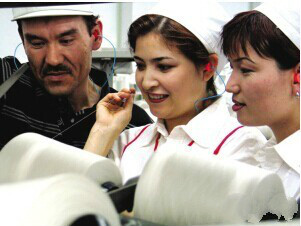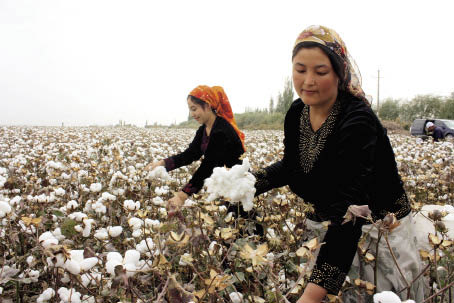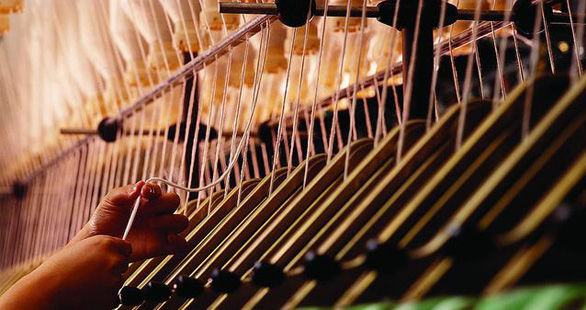
To make full use of Urumqi region, information, logistics, trade and other aspects of the advantages of accelerating the construction of Xinjiang textile and garment industry center. In the CPPCC Xinjiang Uygur Autonomous Region during the fifth session of the Eleventh Committee, the regional Federation of Industry and Commerce Vice Chairman, Dehui Industrial Group Chairman Jin Jin-resistant members of the appeal.
Government work report mentioned in 2017 to promote industrial restructuring and upgrading, said that vigorously develop the textile and garment, food processing, ethnic medicine, national handicrafts and other labor-intensive industries, and strive to complete the textile and garment industry investment 60 billion yuan, new employment 10 million people , Value-added growth of more than 40%.
Qian Jinnai said that in the autonomous region "on the development of textile and garment industry to stimulate employment" and "the development of textile and garment industry driven employment plan" are clearly put forward to make full use of Urumqi region, information, logistics, trade and other advantages , Construction of Xinjiang international textile and apparel business center. The center is the regional textile and garment industry, "three seven parks and one center," the development of strategic layout and an important link in the textile and garment industry, an important support for new employment.
Qian Jinai said that at present, the textile and garment industry in the three cities, seven parks to promote a very good building, the current sent in this "center" on the development of key focus, the center includes creativity, design, display, personnel training, electronics Business, trade and other aspects of the six aspects, according to the planning of this "center" to be built in Urumqi.
Qian Jinnai pointed out that in recent years, through the national and autonomous regions in the policy support, the formation of policy depression has attracted many well-known domestic textile and garment enterprises to Xinjiang investment and construction, but also to promote small and medium-sized Xinjiang national textile enterprises Rapid development, to a large extent led the employment of labor in southern Xinjiang, large enterprises have their own mature marketing channels and networks, and small and medium-sized enterprises in the design, creativity, marketing channels, etc. can not keep up with the progress of enterprise development, which There is an urgent need to build such a "center" for small and medium-sized textile and garment enterprises.
"The production of textile and garment industry enterprises can solve a certain labor force employment, but the 'center' construction is the key to sustained and healthy development of the industry, once lagging behind, it may drag the whole industry hind legs. "Center" in the autonomous region focused on the implementation of the development of textile and garment industry driven employment strategy plays an irreplaceable role, need to get some policy support, thus accelerating its construction.
Qian Jin-resistant in the submission of the proposal called on the Government and relevant departments in accordance with the policy to support textile and garment manufacturing enterprises, "Center" in the construction of special funds, financial loans discount, preferential tariffs, training and social security and so on to give more strong support.
(From Tianshan network)
Recent survey report shows that in 2017 the national cotton acreage increased year on year, is expected to reverse the decline in cotton area for five consecutive years the trend. In 2016, the cotton-growing area of the Yellow River valley was better than that of corn and soybean, but lower than that of pepper and garlic, so the enthusiasm of planting cotton increased slightly, up by 1.41% year-on-year. Cotton production in the Yangtze River Basin since the sowing weather conditions are poor, in some areas affected, yield decline, quality declined, but the cotton purchase price is higher than last year, cotton farmers enthusiasm has picked up. So planting enthusiasm has also increased slightly, up 3.53%. It can be seen from the above results, in 2017 the national cotton area increase will be a high probability event.

In recent years, due to factors such as price, domestic cotton planting experience Waterloo, not only a substantial reduction in area, but also the quality of varying degrees of decline. Recently, China Cotton Association announced the cotton acreage survey report shows that in 2017 the country's cotton acreage increased year on year, is expected to reverse the decline in cotton area for five consecutive years the trend.
In fact, 2017 cotton acreage increase should be reasonable. As the past three years, the implementation of the Xinjiang cotton price subsidy policy, Xinjiang cotton area in accordance with the planned reduction in order to withdraw, there is no decline in cliff-type situation. Although the Xinjiang cotton price subsidy is a three-year pilot, but the determination of the future national protection of cotton farmers will not change, after all, cotton as a strategic material, the country has a very important significance and role.
Xinjiang, a few years ago, cotton farmers to switch to other cash crops did not receive the expected benefits, and even some of the more serious loss of cotton farmers. Only this year, Xinjiang, some fruits and vegetables and other cash crops encountered market winter, not only low prices, and sales difficulties. For example, many farmers in Xinjiang this year, planting watermelon on the loss of many watermelon and even rotten in the ground unmanned harvest, because the cost of hire hired harvest has been higher than the sales price. Similar examples and many. The lack of national purchasing and storage and subsidy policies, the benefits of these farmers can not be guaranteed, contrary to the cultivation of cotton at the very least have the protection of national policy.
2016 cotton market conditions there have been a rare turn, not only Zheng cotton disk rose sharply, the spot market has continued to rise. Higher cotton prices, natural cotton farmers is a major positive. A farmer in southern Xinjiang said that in 2016 the average price of hand-picked cotton at 7.0 yuan / kg or more, the average yield of 350 kg, access to a certain degree of cotton benefits. If you count the subsidies, cotton farmers will further increase revenue. In other crops, a substantial decline in income, the benefits of cotton increased rather than increased cotton planting area next year will certainly have a significant role in promoting.
After the New Year's Day, more than a result of the market continues to slump, the downstream part of the fabric factory intends to early suspension of the news, by understanding the recent gray cloth on the market, whether single or single, the number of 1 million -2 million meters in the downstream market The weakening of demand, no doubt to the textile enterprises before the Spring Festival of yarn sales bring greater pressure.
It is understood that the overall sales of yarn in Shandong and Henan region to the main conventional continental goods, low-end yarn sales in December to maintain the overall level of price flexibility by volume adjustment of space, although the price defensive high-end market, but the current sales in the relative Pre-down somewhat. According to feedback, due to fluctuations in raw material prices, the current price of yarn market mess. At the same time the price difference mostly due to the manufacturers based on their actual situation may be different, Hebei yarn market relative to the Shandong market is generally higher, such as T65 / C3545S yarn, Hebei factory price 18,300 yuan / ton factory, and Shandong factory price 17800 Yuan / ton, there may be different quality, business positioning and other reasons, resulting in a difference of 500 yuan per ton of yarn.
But each have their own customer groups, although the price difference, the downstream buyers under normal circumstances to ensure the quality of the stable, the price as long as they can afford in the range, will not easily replace the supplier. Cotton yarn has been a weak sales, raw material uncertainty led to the textile enterprises to control the number of stocks, rather stop heavy volume storage, most companies are more or less at this stage in a vicious cycle of malignancy in the state.
Source: Global Textile Network






